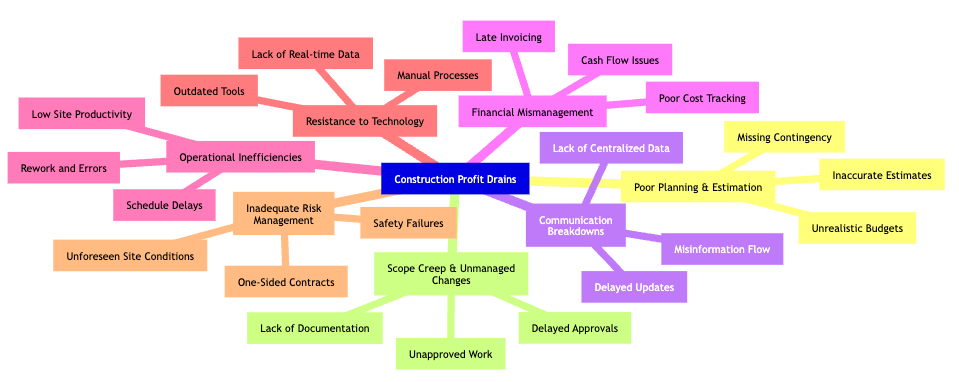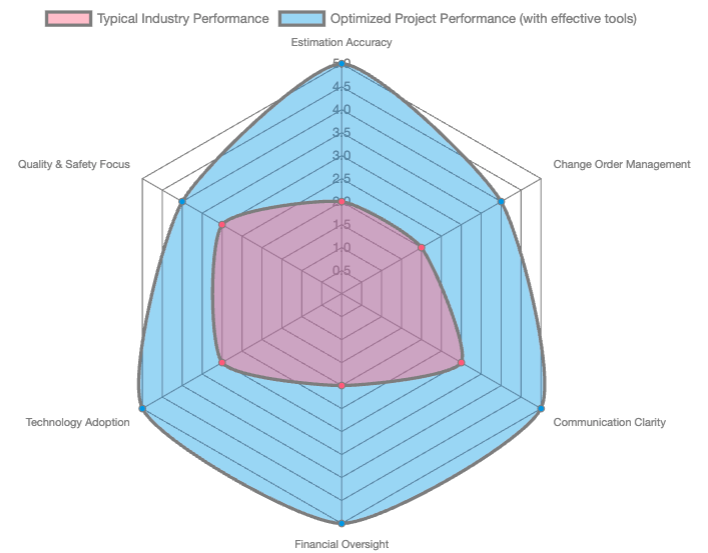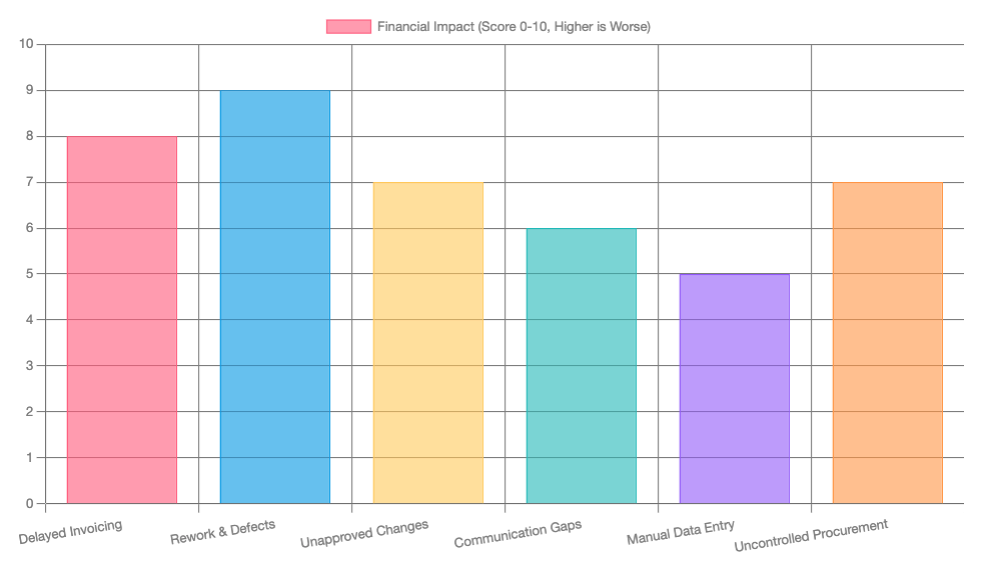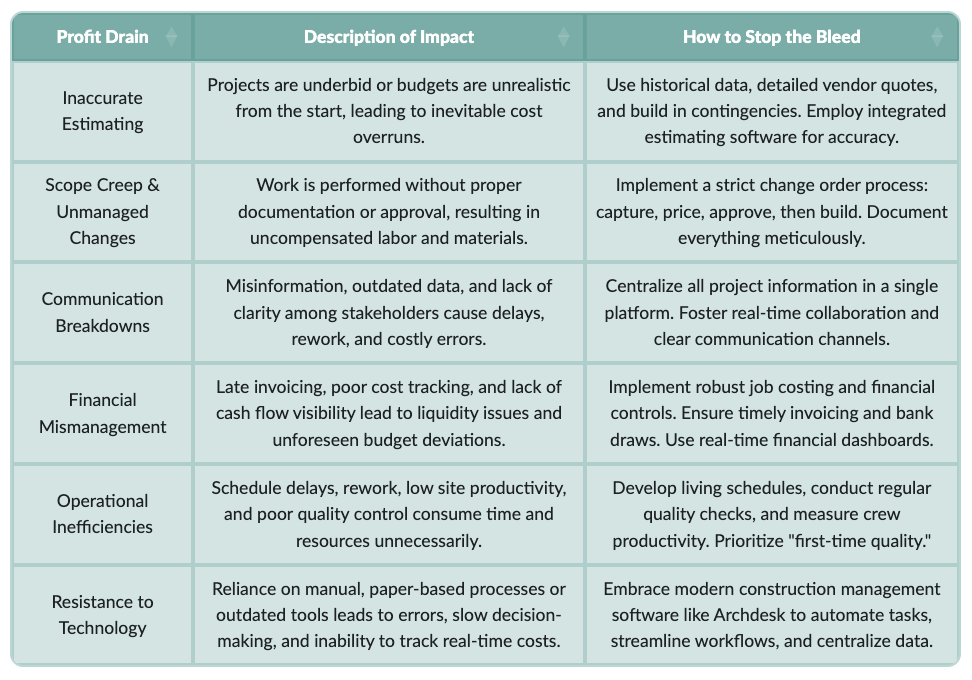Key Insights for Building Smarter
- Inaccurate estimates and poor planning often doom projects before they even start, leading to significant cost overruns and wasted resources.
- Communication breakdowns and financial mismanagement act as silent killers, eroding profits through missed details, late invoicing, and a lack of real-time cost visibility.
- Embracing modern construction management software like Archdesk is crucial for centralizing data, automating processes, and providing the insights needed to stop financial leaks and boost profitability.
Have you ever watched a construction project unfold, seemingly successful on the surface, only to realize the profit you expected just... isn't there? It’s a frustratingly common scenario in our industry. You put in the hard work, the hours, the expertise, and yet, the numbers at the end tell a different story. Honestly, it feels like money just evaporates sometimes, doesn't it?
Construction has notoriously thin margins, and that means every small misstep can have a magnified effect on your bottom line. It’s rarely one huge mistake that sinks a project; more often, it’s a collection of tiny leaks, each dripping away a bit of your hard-earned cash. But the good news is, once you understand these leaks, you can plug them.

It's a common sight: a construction site buzzing with activity, while profits slowly drain away.
Where Does the Money Really Go?
Let's face it, nobody enters a project hoping to lose money. So, what are these sneaky culprits draining your company’s finances? It turns out, many of them are interconnected, creating a chain reaction that can be tough to break without the right approach.
Sketchy Starts: The Perils of Poor Planning and Estimation
Imagine setting out on a long road trip without a map or a clear idea of your destination. That’s what starting a construction project with inaccurate estimates feels like. This is where many projects are basically doomed before the first shovel even hits the dirt. Underestimating labor, misjudging material quantities, or just creating a budget that’s more hope than reality can erase your entire profit margin.
You know, if you don't spend enough time in pre-construction planning, your budget won't stand on solid ground. This isn’t just about being a little off; we’re talking about significant cost overruns that can surprise everyone. For example, if you mistakenly order too few beams for a house, you’ll halt work, reorder, and probably pay extra for expedited shipping. That’s money and time you hadn’t accounted for, and it piles up.
The Silent Killer: Scope Creep and Unmanaged Changes
Ah, scope creep. It's profit creep’s evil twin, always lurking. The client asks for a "small tweak" here, a "minor adjustment" there, and before you know it, that tiny change has snowballed. It ripples through the entire project, adding countless unplanned hours and unforeseen material costs. If you’re not meticulously tracking these changes with proper change orders, well, you’re basically doing free work. And that, my friends, is a surefire way to lose money.
Work done without a signed change order is charity. Period. You need a standardized workflow: capture the change, price it, get approval, and then build. Don't forget to record time and materials daily for any disputed work. Owners, whether in North America, Europe, or the GCC, generally respect clear documentation, even if they push back a bit on the price. Sloppy notes? They just invite write-offs.

Are your project details buried under a mountain of paperwork? This can lead to costly oversight.
The Echo Chamber: Communication Breakdowns
Ever played that game "telephone" where the message gets completely garbled by the end? That’s often what happens on construction sites when communication goes sideways. You've got project managers, site crews, subcontractors, suppliers, and the client—all needing to be in sync. When they’re not, everything gets more expensive.
A detail missed in an email, a drawing not updated, a delivery that shows up late because someone wasn’t informed… these small failures compound into major delays and cost overruns. Relying on a scattered mess of emails, paper reports, and phone calls is a recipe for disaster. Information gets lost, decisions are made on outdated data, and suddenly you're fixing something because a sub didn't get the memo.

This mindmap illustrates the interconnected web of factors that commonly drain profits from construction projects.
The Budget Black Hole: Financial Mismanagement
This is a big one. For many contractors, the financial side of the business can feel like an afterthought. But poor financial controls will sink you faster than a faulty foundation. Invoicing late, missing bank draws, and not having a tight grip on job costing are classic mistakes. Honestly, without real-time visibility into your costs, you’re flying blind. You might think a project is profitable until the very end, when you realize you blew the budget on labor or materials months ago. By then, it’s too late to fix it. Cash flow, you know, is the lifeblood of any construction business, and when it slows to a trickle, even profitable companies can fail.
Construction accounting isn't like regular accounting. It deals with constant cost changes, multiple job sites, and long project timelines. That’s why generic software just doesn’t cut it. You need to reconcile committed, incurred, and billed amounts every single week. Cash is oxygen; don’t hold your breath!
Stuck in the Past: Resisting Technology
Honestly, this is the hurdle that surprises us the most. So many construction companies are running their multi-million-dollar operations on spreadsheets, paper, and… hope. That might have worked twenty years ago, but not today. Manual processes are slow, prone to errors, and just can't give you the real-time data you need to make smart decisions. Information gets lost, delayed, or misread, leading to inefficiencies and lost profits.
The right construction management software isn’t just a fancy tool; it’s like the central nervous system for your business. It connects your estimating, scheduling, procurement, and financials in one place. It automates those tedious tasks that eat up your team’s time and gets rid of the data silos that cause communication breakdowns.
Cutting Corners, Paying Double: Ignoring Safety and Quality
Sacrificing safety and quality might seem like a way to save money in the short term, but it almost always backfires spectacularly. Poor safety planning leads to accidents, costly delays, and even legal battles. And inadequate quality control? That means work has to be redone, incurring additional costs and pushing back completion dates. Doing the work right the first time saves a lot of trouble and money.
Rework absolutely kills margins. So does waiting. Clear shop drawings, QC checklists, and first-work inspections really cut down on redos. Think about it: a small investment in robust safety protocols and quality checks upfront can save you a fortune in corrective actions and legal fees later on.
How to Stop the Bleed and Reclaim Your Profits
So, how do you turn this around? How do you stop those pesky financial leaks? It boils down to a few key areas: meticulous planning, crystal-clear communication, rigorous financial oversight, prioritizing safety and quality, and, crucially, embracing modern technology.
The Power of Precision: Estimating and Planning with Confidence
Stopping the financial bleed on your projects starts with a commitment to precision. Use historical data from past projects to make your bids smarter, not just lower. Build estimates from actual production rates, solid vendor quotes, and always, always include a contingency. Track estimate versus actual costs weekly, not just at month-end. You need to make variance visible fast, not wait for a month-end autopsy.
Building a living schedule that includes critical path, float, and resource logic is essential. Re-baseline only when absolutely necessary. Daily huddles should link field reality back to the schedule and, critically, to cost. If you can’t see slippage by week two, week eight will be painful.
Smart Procurement and Bulletproof Financial Controls
Profit gets set at buyout. Late purchase orders, no price locks, and piecemeal subcontracts are just invitations for overruns. Secure key materials early, especially when markets are volatile. Use frame agreements where you can. Track committed cost versus budget and forecast the end cost every single week. Surprises belong in birthday parties, not cost reports, right?
And on the financial front, bill on time with complete backup. Code costs to specific work packages so you know exactly which areas are bleeding. It's about knowing your financial health at any given moment, not just at month-end when it’s too late.

This radar chart compares typical industry performance against optimized project performance, highlighting areas where strategic improvements can significantly boost efficiency and profitability.
The Archdesk Advantage: Your Project's Quiet Guardian
You can try to wrangle all this with spreadsheets, but honestly, you’ll miss things. Archdesk pulls all the moving parts into one connected place. It’s not just about fancy gadgets; it’s about making your business more efficient, cutting costs, and boosting your profitability.
Archdesk connects your estimating directly to job costing, carrying your estimates straight into budgets, cost codes, and forecasts. This way, variance is real, not just a guess. It streamlines change management too: log, price, route for approval, and push to billing with the paper trail owners expect. For procurement and commitments, you can issue POs and subcontracts directly from your budgets, tracking committed versus remaining to avoid silent overspends. Plus, its scheduling talks directly to cost, letting you see planned tasks, actual progress, and earned value side by side. From the field to the office, mobile time entries, photos, and daily logs feed cost and progress the very same day, not two weeks later.
Unlike some of the bulkier options out there, which can feel overwhelming, Archdesk keeps things straightforward. It’s practical help that fits construction workflows, whether you're in the US, Europe, or overseas. It's built specifically for our industry, integrating everything from project management to financial controls and document management into one unified platform.

This bar chart illustrates the relative financial impact of various common profit drains in construction, scaled from 0 (minimal impact) to 10 (severe impact).
Table: Common Profit Drains and Their Solutions
To summarize, here's a quick overview of the most common issues that erode your profits and how you can combat them effectively.

FAQ: Your Burning Questions Answered
What's the biggest reason construction projects lose money?
Honestly, it's rarely just one thing, but inaccurate estimating and poor planning at the very beginning are huge culprits. If your initial numbers are off, it's an uphill battle from day one.
How can I prevent scope creep from eating my profits?
The key is a strict change order process. Don't do any work without a signed approval and clear documentation. Capture, price, and get approval for every change, no matter how small it seems.
Why is cash flow such a big deal in construction?
Cash flow is like oxygen for your business. Even if a project looks profitable on paper, if money isn't coming in steadily (due to late invoicing or missed draws), you can face serious liquidity problems and even business failure.
Can technology really help small construction companies?
Absolutely! Many smaller companies mistakenly think technology is just for the big players. But even small teams can benefit massively from centralizing data, automating tasks, and getting real-time insights, which helps avoid costly errors and improve efficiency.
Conclusion: Building a More Profitable Future
Projects lose money when problems stay invisible. It’s like a slow leak in a tire; if you don’t find it, you’ll eventually be stranded. Making these issues visible early, standardizing the "boring" but crucial things, protecting your cash flow, and giving your team a system that truly closes the gaps are paramount. The goal isn’t just to complete projects; it’s to complete them profitably. By tightening up these common areas and leveraging tools like Archdesk, you can stop leaving money on the table and start building a business that’s as financially solid as the structures you create. It feels pretty good, you know, knowing where every penny goes.
References
9 Reasons to Buy Construction Management Software | Archdesk Blog
Why It's a Top Contender for Best Construction Software
5 Ways Contractors Lose Money - LinkedIn
From Spreadsheets to Smart Software: Why It's Time to Upgrade ...





